|
PLearn 0.1
|
|
PLearn 0.1
|
#include <VPLProcessor.h>
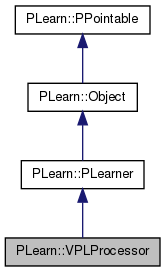
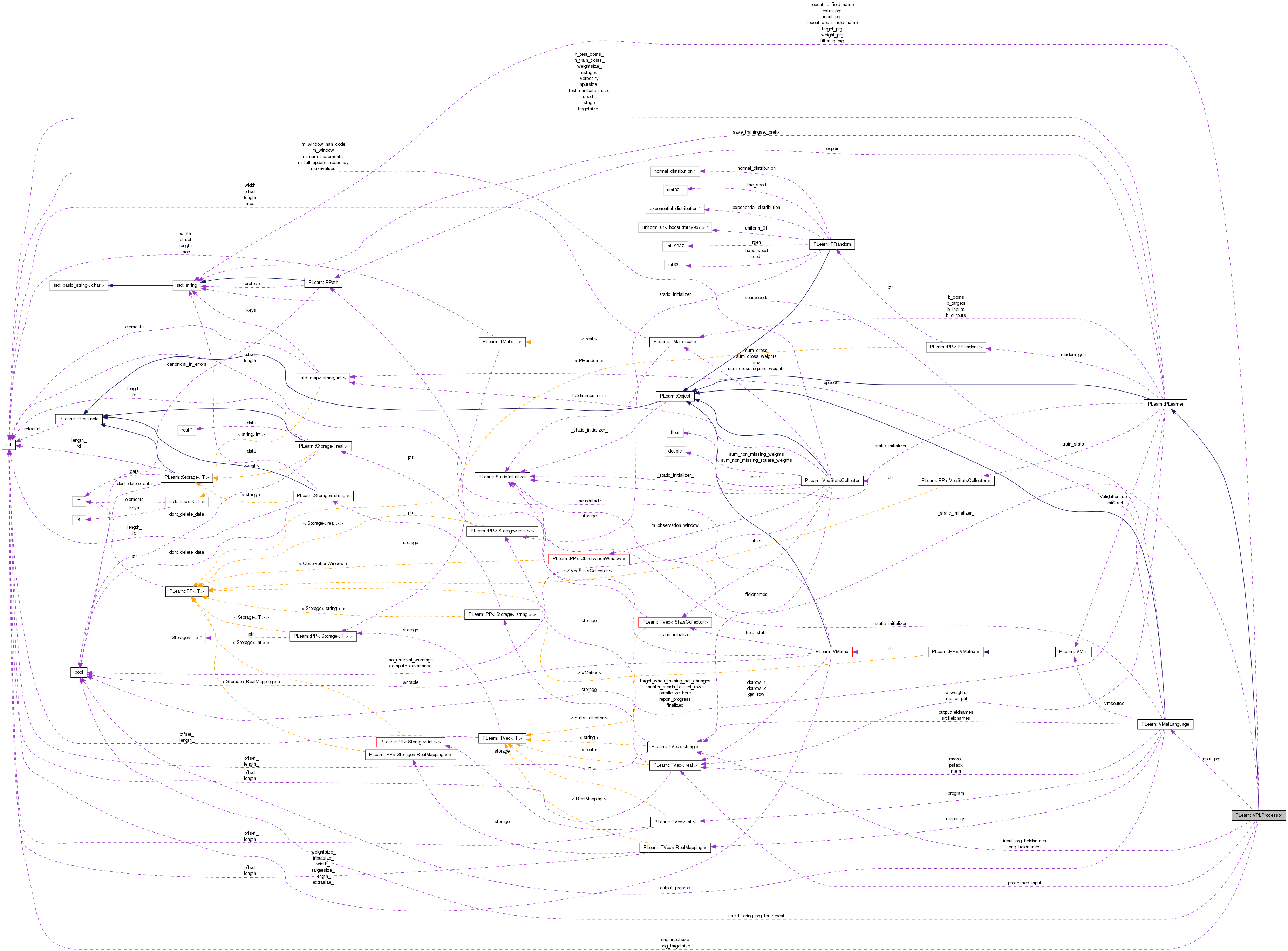
Public Member Functions | |
| VPLProcessor () | |
| Default constructor. | |
| virtual void | build () |
| Simply calls inherited::build() then build_(). | |
| virtual void | makeDeepCopyFromShallowCopy (CopiesMap &copies) |
| Transforms a shallow copy into a deep copy. | |
| virtual string | classname () const |
| virtual OptionList & | getOptionList () const |
| virtual OptionMap & | getOptionMap () const |
| virtual RemoteMethodMap & | getRemoteMethodMap () const |
| virtual VPLProcessor * | deepCopy (CopiesMap &copies) const |
| virtual int | outputsize () const |
| SUBCLASS WRITING: override this so that it returns the size of this learner's output, as a function of its inputsize(), targetsize() and set options. | |
| virtual void | forget () |
| Forwarded to inner learner. | |
| virtual void | setTrainingSet (VMat training_set, bool call_forget=true) |
| virtual void | computeOutput (const Vec &input, Vec &output) const |
| *** SUBCLASS WRITING: *** | |
| virtual void | computeOutputAndCosts (const Vec &input, const Vec &target, Vec &output, Vec &costs) const |
| Default calls computeOutput and computeCostsFromOutputs. | |
| virtual void | computeCostsFromOutputs (const Vec &input, const Vec &output, const Vec &target, Vec &costs) const |
| *** SUBCLASS WRITING: *** | |
| virtual TVec< string > | getOutputNames () const |
| If there's an output_prg, it returns output_prg_fieldnames If there's no output_prg, the call is forwarded to the inner learner. | |
| virtual VMat | processDataSet (VMat dataset) const |
| Process a full dataset (possibly containing input,target,weight,extra parts). | |
| virtual void | train () |
| *** SUBCLASS WRITING: *** | |
| virtual TVec< std::string > | getTestCostNames () const |
| *** SUBCLASS WRITING: *** | |
| virtual TVec< string > | getTrainCostNames () const |
| *** SUBCLASS WRITING: *** | |
Static Public Member Functions | |
| static string | _classname_ () |
| static OptionList & | _getOptionList_ () |
| static RemoteMethodMap & | _getRemoteMethodMap_ () |
| static Object * | _new_instance_for_typemap_ () |
| static bool | _isa_ (const Object *o) |
| static void | _static_initialize_ () |
| static const PPath & | declaringFile () |
Public Attributes | |
| string | filtering_prg |
| string | input_prg |
| string | target_prg |
| string | weight_prg |
| string | extra_prg |
Static Public Attributes | |
| static StaticInitializer | _static_initializer_ |
Static Protected Member Functions | |
| static void | declareOptions (OptionList &ol) |
| Declares this class' options. | |
Protected Attributes | |
| VMatLanguage | input_prg_ |
| TVec< string > | input_prg_fieldnames |
| Vec | processed_input |
| TVec< string > | orig_fieldnames |
| int | orig_inputsize |
| int | orig_targetsize |
| bool | use_filtering_prg_for_repeat |
| string | repeat_id_field_name |
| string | repeat_count_field_name |
Private Types | |
| typedef PLearner | inherited |
Private Member Functions | |
| void | build_ () |
| This does the actual building. | |
| void | initializeInputPrograms () |
Definition at line 52 of file VPLProcessor.h.
typedef PLearner PLearn::VPLProcessor::inherited [private] |
Reimplemented from PLearn::PLearner.
Definition at line 57 of file VPLProcessor.h.
| PLearn::VPLProcessor::VPLProcessor | ( | ) |
Default constructor.
Definition at line 53 of file VPLProcessor.cc.
:orig_inputsize(-1), orig_targetsize(-1), use_filtering_prg_for_repeat(false), repeat_id_field_name(""), repeat_count_field_name("") { }
| string PLearn::VPLProcessor::_classname_ | ( | ) | [static] |
Reimplemented from PLearn::PLearner.
Definition at line 66 of file VPLProcessor.cc.
| OptionList & PLearn::VPLProcessor::_getOptionList_ | ( | ) | [static] |
Reimplemented from PLearn::PLearner.
Definition at line 66 of file VPLProcessor.cc.
| RemoteMethodMap & PLearn::VPLProcessor::_getRemoteMethodMap_ | ( | ) | [static] |
Reimplemented from PLearn::PLearner.
Definition at line 66 of file VPLProcessor.cc.
Reimplemented from PLearn::PLearner.
Definition at line 66 of file VPLProcessor.cc.
| Object * PLearn::VPLProcessor::_new_instance_for_typemap_ | ( | ) | [static] |
Reimplemented from PLearn::Object.
Definition at line 66 of file VPLProcessor.cc.
| StaticInitializer VPLProcessor::_static_initializer_ & PLearn::VPLProcessor::_static_initialize_ | ( | ) | [static] |
Reimplemented from PLearn::PLearner.
Definition at line 66 of file VPLProcessor.cc.
| void PLearn::VPLProcessor::build | ( | ) | [virtual] |
Simply calls inherited::build() then build_().
Reimplemented from PLearn::PLearner.
Definition at line 132 of file VPLProcessor.cc.
References PLearn::PLearner::build(), and build_().
{
inherited::build();
build_();
}
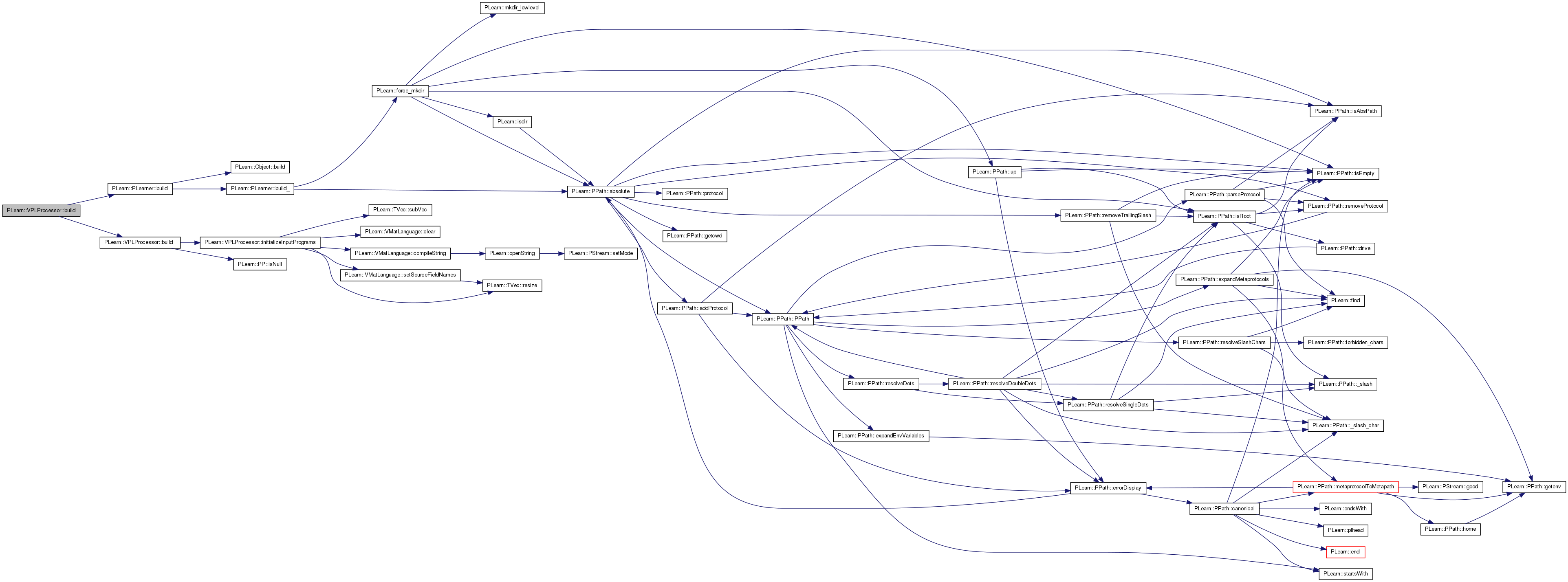
| void PLearn::VPLProcessor::build_ | ( | ) | [private] |
This does the actual building.
Reimplemented from PLearn::PLearner.
Definition at line 125 of file VPLProcessor.cc.
References initializeInputPrograms(), PLearn::PP< T >::isNull(), orig_inputsize, orig_targetsize, and PLearn::PLearner::train_set.
Referenced by build().
{
// We're probably reloading a saved VPLProcessor
if(train_set.isNull() && (orig_inputsize>0 || orig_targetsize>0) )
initializeInputPrograms();
}


| string PLearn::VPLProcessor::classname | ( | ) | const [virtual] |
Reimplemented from PLearn::Object.
Definition at line 66 of file VPLProcessor.cc.
| void PLearn::VPLProcessor::computeCostsFromOutputs | ( | const Vec & | input, |
| const Vec & | output, | ||
| const Vec & | target, | ||
| Vec & | costs | ||
| ) | const [virtual] |
*** SUBCLASS WRITING: ***
This should be defined in subclasses to compute the weighted costs from already computed output. The costs should correspond to the cost names returned by getTestCostNames().
NOTE: In exotic cases, the cost may also depend on some info in the input, that's why the method also gets so see it.
Implements PLearn::PLearner.
Definition at line 276 of file VPLProcessor.cc.
References computeOutputAndCosts().
{
Vec nonconst_output = output; // to make the constipated compiler happy
computeOutputAndCosts(input, target, nonconst_output, costs);
}
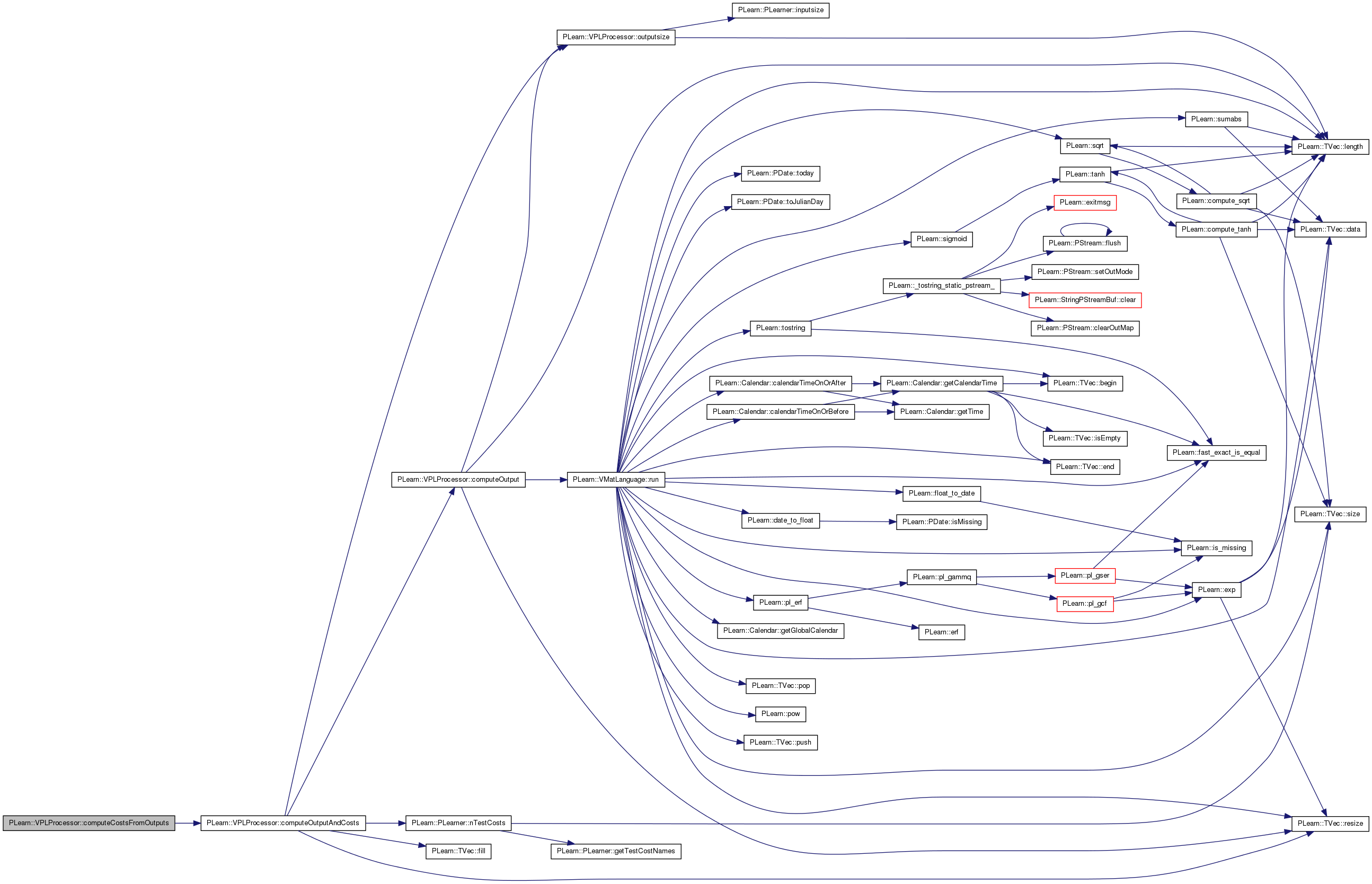
*** SUBCLASS WRITING: ***
This should be defined in subclasses to compute the output from the input.
Reimplemented from PLearn::PLearner.
Definition at line 252 of file VPLProcessor.cc.
References input_prg, input_prg_, input_prg_fieldnames, PLearn::TVec< T >::length(), outputsize(), processed_input, PLearn::TVec< T >::resize(), and PLearn::VMatLanguage::run().
Referenced by computeOutputAndCosts().
{
output.resize(outputsize());
Vec newinput = input;
if (!input_prg.empty())
{
processed_input.resize(input_prg_fieldnames.length());
input_prg_.run(input, processed_input);
newinput= processed_input;
}
output << newinput;
}
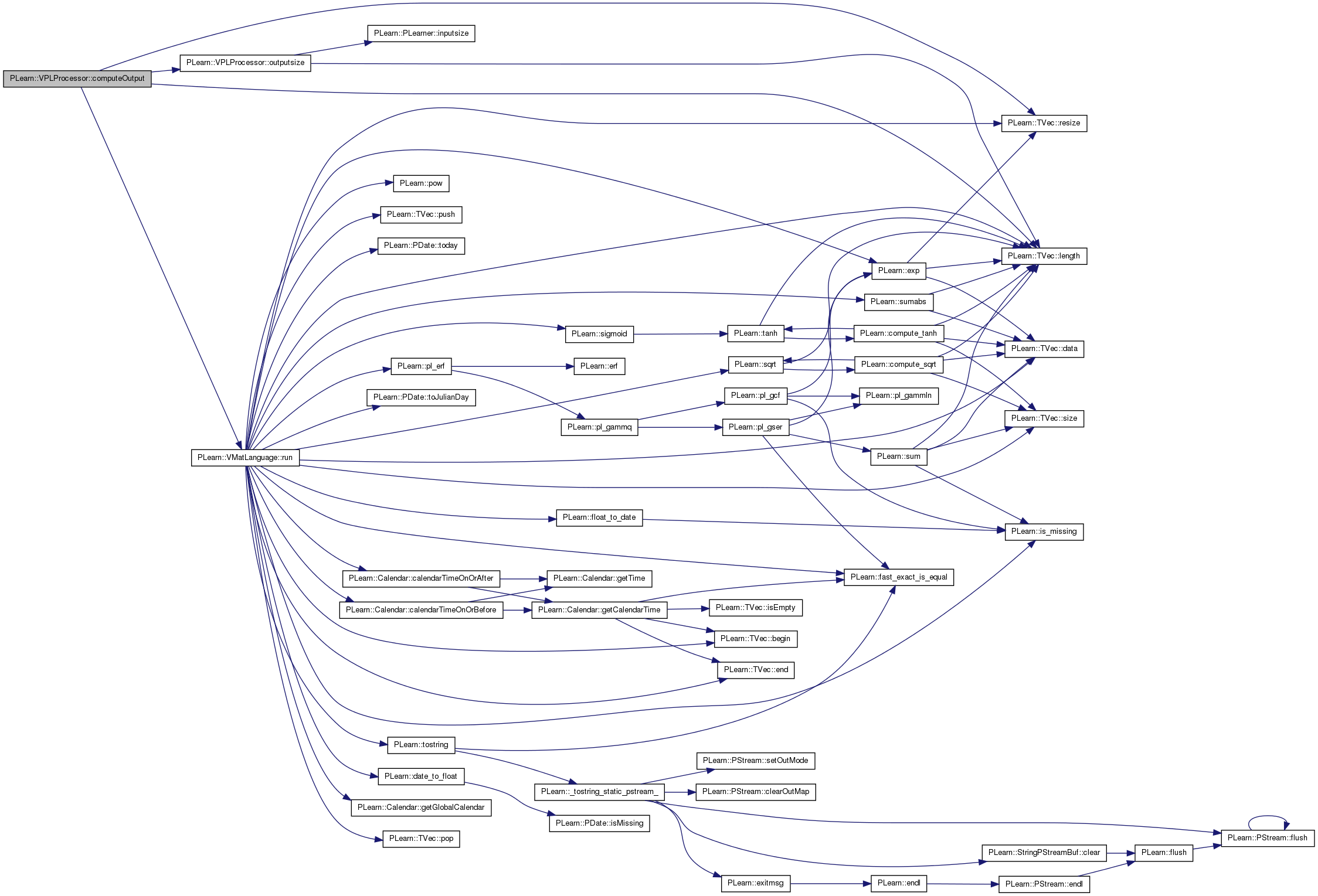

| void PLearn::VPLProcessor::computeOutputAndCosts | ( | const Vec & | input, |
| const Vec & | target, | ||
| Vec & | output, | ||
| Vec & | costs | ||
| ) | const [virtual] |
Default calls computeOutput and computeCostsFromOutputs.
You may override this if you have a more efficient way to compute both output and weighted costs at the same time.
Reimplemented from PLearn::PLearner.
Definition at line 266 of file VPLProcessor.cc.
References computeOutput(), PLearn::TVec< T >::fill(), PLearn::PLearner::nTestCosts(), outputsize(), and PLearn::TVec< T >::resize().
Referenced by computeCostsFromOutputs().
{
output.resize(outputsize());
costs.resize(nTestCosts());
costs.fill(-1);
return computeOutput(input, output);
}
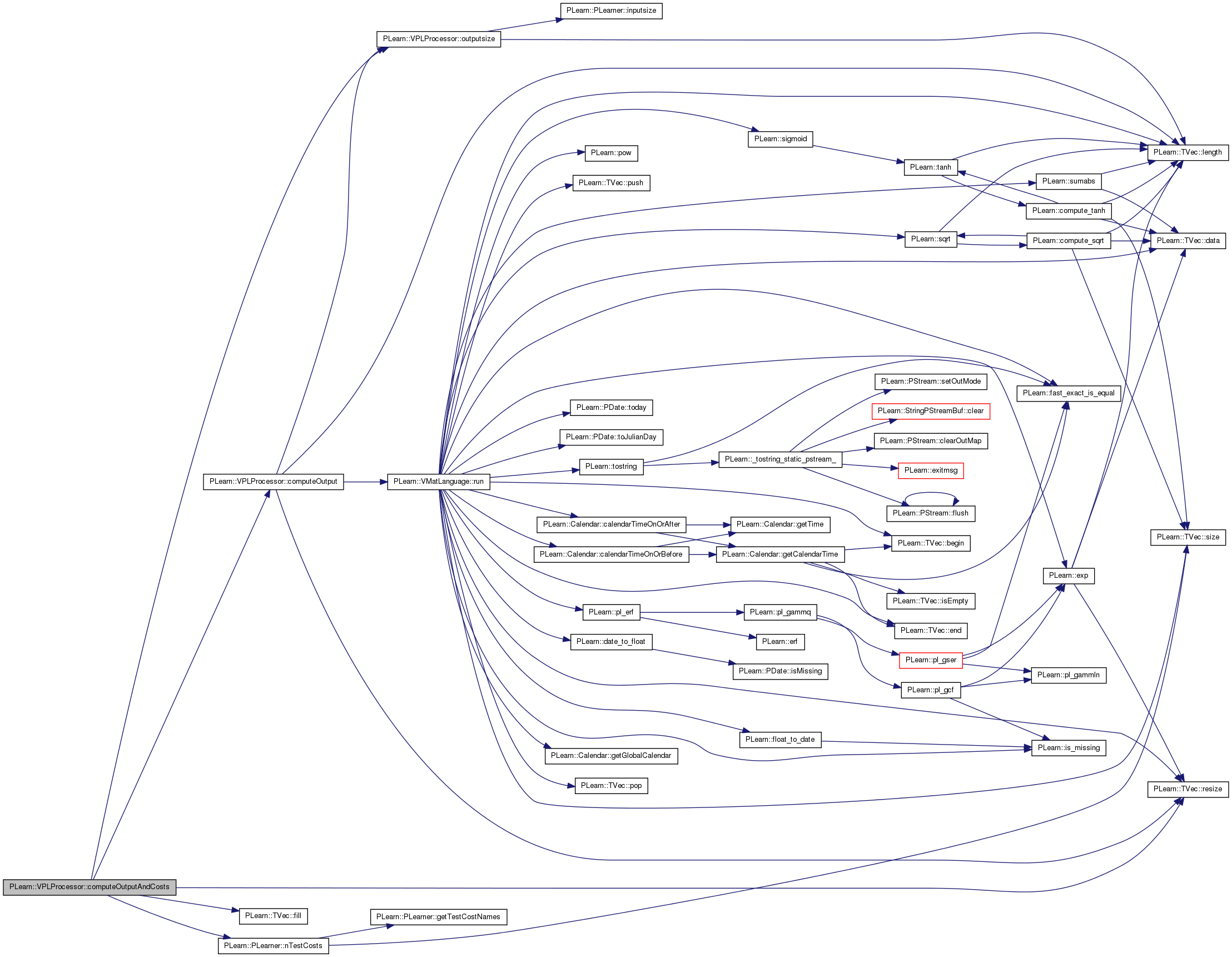

| void PLearn::VPLProcessor::declareOptions | ( | OptionList & | ol | ) | [static, protected] |
Declares this class' options.
Reimplemented from PLearn::PLearner.
Definition at line 68 of file VPLProcessor.cc.
References PLearn::OptionBase::buildoption, PLearn::declareOption(), PLearn::PLearner::declareOptions(), extra_prg, filtering_prg, input_prg, PLearn::OptionBase::learntoption, orig_fieldnames, orig_inputsize, orig_targetsize, repeat_count_field_name, repeat_id_field_name, target_prg, use_filtering_prg_for_repeat, and weight_prg.
{
declareOption(ol, "filtering_prg", &VPLProcessor::filtering_prg, OptionBase::buildoption,
"Optional program string in VPL language to apply as filtering on the training VMat.\n"
"This program is to produce a single value interpreted as a boolean: only the rows for which\n"
"it evaluates to non-zero will be kept.\n"
"An empty string means NO FILTERING.");
declareOption(ol, "input_prg", &VPLProcessor::input_prg, OptionBase::buildoption,
"Program string in VPL language to be applied to each raw input \n"
"to generate the new preprocessed input.\n"
"Note that names must be given to the generated values with :fieldname VPL syntax.\n"
"An empty string means NO PREPROCESSING. (initial raw input is used as is)");
declareOption(ol, "target_prg", &VPLProcessor::target_prg, OptionBase::buildoption,
"Program string in VPL language to be applied to a dataset row\n"
"to generate a proper target.\n"
"Note that names must be given to the generated values with :fieldname VPL syntax.\n"
"If it's an empty string, then we'll use the original target from the data set");
declareOption(ol, "weight_prg", &VPLProcessor::weight_prg, OptionBase::buildoption,
"Program string in VPL language to be applied to a dataset row\n"
"to generate a proper weight.\n"
"Note that names must be given to the generated values with :fieldname VPL syntax.\n"
"If it's an empty string, then we'll use the original weight from the data set");
declareOption(ol, "extra_prg", &VPLProcessor::extra_prg, OptionBase::buildoption,
"Program string in VPL language to be applied to a dataset row\n"
"to generate proper extra fields.\n"
"Note that names must be given to the generated values with :fieldname VPL syntax.\n"
"If it's an empty string, then we'll use the original extra fields from the data set");
declareOption(ol, "use_filtering_prg_for_repeat", &VPLProcessor::use_filtering_prg_for_repeat, OptionBase::buildoption,
"When true, the result of the filtering program indicates the number of times a row should be repeated (0..n).\n"
"(sets FilteredVMatrix::allow_repeat_rows.)");
declareOption(ol, "repeat_id_field_name", &VPLProcessor::repeat_id_field_name, OptionBase::buildoption,
"Field name for the repetition id (0, 1, ..., n-1). No field is added if empty.");
declareOption(ol, "repeat_count_field_name", &VPLProcessor::repeat_count_field_name, OptionBase::buildoption,
"Field name for the number of repetitions (n). No field is added if empty.");
// learnt
declareOption(ol, "orig_fieldnames", &VPLProcessor::orig_fieldnames, OptionBase::learntoption,
"original fieldnames of the training set");
declareOption(ol, "orig_inputsize", &VPLProcessor::orig_inputsize, OptionBase::learntoption,
"original inputsize of the training set");
declareOption(ol, "orig_targetsize", &VPLProcessor::orig_targetsize, OptionBase::learntoption,
"original targetsize of the training set");
// Now call the parent class' declareOptions
inherited::declareOptions(ol);
}

| static const PPath& PLearn::VPLProcessor::declaringFile | ( | ) | [inline, static] |
Reimplemented from PLearn::PLearner.
Definition at line 136 of file VPLProcessor.h.
| VPLProcessor * PLearn::VPLProcessor::deepCopy | ( | CopiesMap & | copies | ) | const [virtual] |
Reimplemented from PLearn::PLearner.
Definition at line 66 of file VPLProcessor.cc.
| void PLearn::VPLProcessor::forget | ( | ) | [virtual] |
Forwarded to inner learner.
Reimplemented from PLearn::PLearner.
Definition at line 159 of file VPLProcessor.cc.
References PLearn::PLearner::forget(), and PLearn::PLearner::stage.
{
inherited::forget();
stage = 0;
}

| OptionList & PLearn::VPLProcessor::getOptionList | ( | ) | const [virtual] |
Reimplemented from PLearn::Object.
Definition at line 66 of file VPLProcessor.cc.
| OptionMap & PLearn::VPLProcessor::getOptionMap | ( | ) | const [virtual] |
Reimplemented from PLearn::Object.
Definition at line 66 of file VPLProcessor.cc.
| TVec< string > PLearn::VPLProcessor::getOutputNames | ( | ) | const [virtual] |
If there's an output_prg, it returns output_prg_fieldnames If there's no output_prg, the call is forwarded to the inner learner.
Reimplemented from PLearn::PLearner.
Definition at line 285 of file VPLProcessor.cc.
References PLearn::PLearner::getTrainingSet(), input_prg, input_prg_fieldnames, and PLERROR.
{
if (!input_prg.empty())//output_prg_)
return input_prg_fieldnames;
VMat trainset= getTrainingSet();
if (trainset==0)
PLERROR("in VPLProcessor::getOutputNames: no train set specified yet.");
return trainset->inputFieldNames();
}

| RemoteMethodMap & PLearn::VPLProcessor::getRemoteMethodMap | ( | ) | const [virtual] |
Reimplemented from PLearn::Object.
Definition at line 66 of file VPLProcessor.cc.
| TVec< std::string > PLearn::VPLProcessor::getTestCostNames | ( | ) | const [virtual] |
*** SUBCLASS WRITING: ***
This should return the names of the costs computed by computeCostsFromOutputs.
Implements PLearn::PLearner.
Definition at line 301 of file VPLProcessor.cc.
{return TVec<string>(0);}
| TVec< string > PLearn::VPLProcessor::getTrainCostNames | ( | ) | const [virtual] |
*** SUBCLASS WRITING: ***
This should return the names of the objective costs that the train method computes and for which it updates the VecStatsCollector train_stats.
Implements PLearn::PLearner.
Definition at line 304 of file VPLProcessor.cc.
{return TVec<string>(0);}
| void PLearn::VPLProcessor::initializeInputPrograms | ( | ) | [private] |
Definition at line 168 of file VPLProcessor.cc.
References PLearn::VMatLanguage::clear(), PLearn::VMatLanguage::compileString(), input_prg, input_prg_, input_prg_fieldnames, orig_fieldnames, orig_inputsize, PLearn::TVec< T >::resize(), PLearn::VMatLanguage::setSourceFieldNames(), and PLearn::TVec< T >::subVec().
Referenced by build_(), and setTrainingSet().
{
if (!input_prg.empty())
{
input_prg_.setSourceFieldNames(orig_fieldnames.subVec(0,orig_inputsize));
input_prg_.compileString(input_prg, input_prg_fieldnames);
}
else
{
input_prg_.clear();
input_prg_fieldnames.resize(0);
}
}


| void PLearn::VPLProcessor::makeDeepCopyFromShallowCopy | ( | CopiesMap & | copies | ) | [virtual] |
Transforms a shallow copy into a deep copy.
Reimplemented from PLearn::PLearner.
Definition at line 140 of file VPLProcessor.cc.
References PLearn::deepCopyField(), input_prg_, input_prg_fieldnames, PLearn::VMatLanguage::makeDeepCopyFromShallowCopy(), PLearn::PLearner::makeDeepCopyFromShallowCopy(), orig_fieldnames, and processed_input.
{
inherited::makeDeepCopyFromShallowCopy(copies);
input_prg_.makeDeepCopyFromShallowCopy(copies);
deepCopyField(input_prg_fieldnames, copies);
deepCopyField(processed_input, copies);
deepCopyField(orig_fieldnames, copies);
}

| int PLearn::VPLProcessor::outputsize | ( | ) | const [virtual] |
SUBCLASS WRITING: override this so that it returns the size of this learner's output, as a function of its inputsize(), targetsize() and set options.
Implements PLearn::PLearner.
Definition at line 151 of file VPLProcessor.cc.
References input_prg, input_prg_fieldnames, PLearn::PLearner::inputsize(), and PLearn::TVec< T >::length().
Referenced by computeOutput(), and computeOutputAndCosts().
{
if (!input_prg.empty())
return input_prg_fieldnames.length();
return inputsize();
}


Process a full dataset (possibly containing input,target,weight,extra parts).
Returns processed view of that dataset. The default version uses computeOutput to process the input part, and simply passes on the other parts unchanged.
Reimplemented from PLearn::PLearner.
Definition at line 204 of file VPLProcessor.cc.
References extra_prg, filtering_prg, PLearn::PLearner::getExperimentDirectory(), input_prg, repeat_count_field_name, repeat_id_field_name, target_prg, PLearn::tostring(), use_filtering_prg_for_repeat, PLearn::PLearner::verbosity, and weight_prg.
{
VMat filtered_dataset = dataset;
PPath filtered_dataset_metadatadir = getExperimentDirectory() / "filtered_dataset.metadata";
if (!filtering_prg.empty())
filtered_dataset = new FilteredVMatrix(dataset, filtering_prg, filtered_dataset_metadatadir, verbosity>1,
use_filtering_prg_for_repeat, repeat_id_field_name, repeat_count_field_name);
// Since ProcessingVMatrix produces 0 length vectors when given an empty
// program (which is not the behavior that VPLProcessors is documented as
// implementing), we need to replace each program that is an empty string
// by a small VPL snippet that copies all the fields for the input or
// target, etc.
// First compute the start of each section (input, target, etc.) in the
// columns of the dataset.
const int start_of_targets = dataset->inputsize();
const int start_of_weights = start_of_targets + dataset->targetsize();
const int start_of_extras = start_of_weights + dataset->weightsize();
// Now compute each processing_*_prg program.
string processing_input_prg = input_prg;
if (processing_input_prg.empty() && dataset->inputsize() > 0) {
processing_input_prg = "[%0:%" + tostring(start_of_targets-1) + "]";
}
string processing_target_prg = target_prg;
if (processing_target_prg.empty() && dataset->targetsize() > 0) {
processing_target_prg = "[%" + tostring(start_of_targets) + ":%" +
tostring(start_of_weights-1) + "]";
}
string processing_weight_prg = weight_prg;
if (processing_weight_prg.empty() && dataset->weightsize() > 0) {
processing_weight_prg = "[%" + tostring(start_of_weights) + ":%" +
tostring(start_of_extras-1) + "]";
}
string processing_extras_prg = extra_prg;
if (processing_extras_prg.empty() && dataset->extrasize() > 0) {
processing_extras_prg = "[%" + tostring(start_of_extras) + ":END]";
}
return new ProcessingVMatrix(filtered_dataset, processing_input_prg,
processing_target_prg, processing_weight_prg,
processing_extras_prg);
}

For example, the next to last line (VMatr processed_trainset = new ...) has no impact.
Reimplemented from PLearn::PLearner.
Definition at line 186 of file VPLProcessor.cc.
References extra_prg, filtering_prg, PLearn::PLearner::getExperimentDirectory(), initializeInputPrograms(), input_prg, orig_fieldnames, orig_inputsize, orig_targetsize, repeat_count_field_name, repeat_id_field_name, PLearn::PLearner::setTrainingSet(), target_prg, use_filtering_prg_for_repeat, PLearn::PLearner::verbosity, and weight_prg.
{
orig_fieldnames = training_set->fieldNames();
orig_inputsize = training_set->inputsize();
orig_targetsize = training_set->targetsize();
initializeInputPrograms();
VMat filtered_trainset = training_set;
PPath filtered_trainset_metadatadir = getExperimentDirectory() / "filtered_train_set.metadata";
if (!filtering_prg.empty())
filtered_trainset = new FilteredVMatrix(training_set, filtering_prg, filtered_trainset_metadatadir, verbosity>1,
use_filtering_prg_for_repeat, repeat_id_field_name, repeat_count_field_name);
// XXX The next line does nothing!
VMat processed_trainset = new ProcessingVMatrix(filtered_trainset, input_prg, target_prg, weight_prg, extra_prg);
inherited::setTrainingSet(training_set, call_forget); // will call forget if needed
}
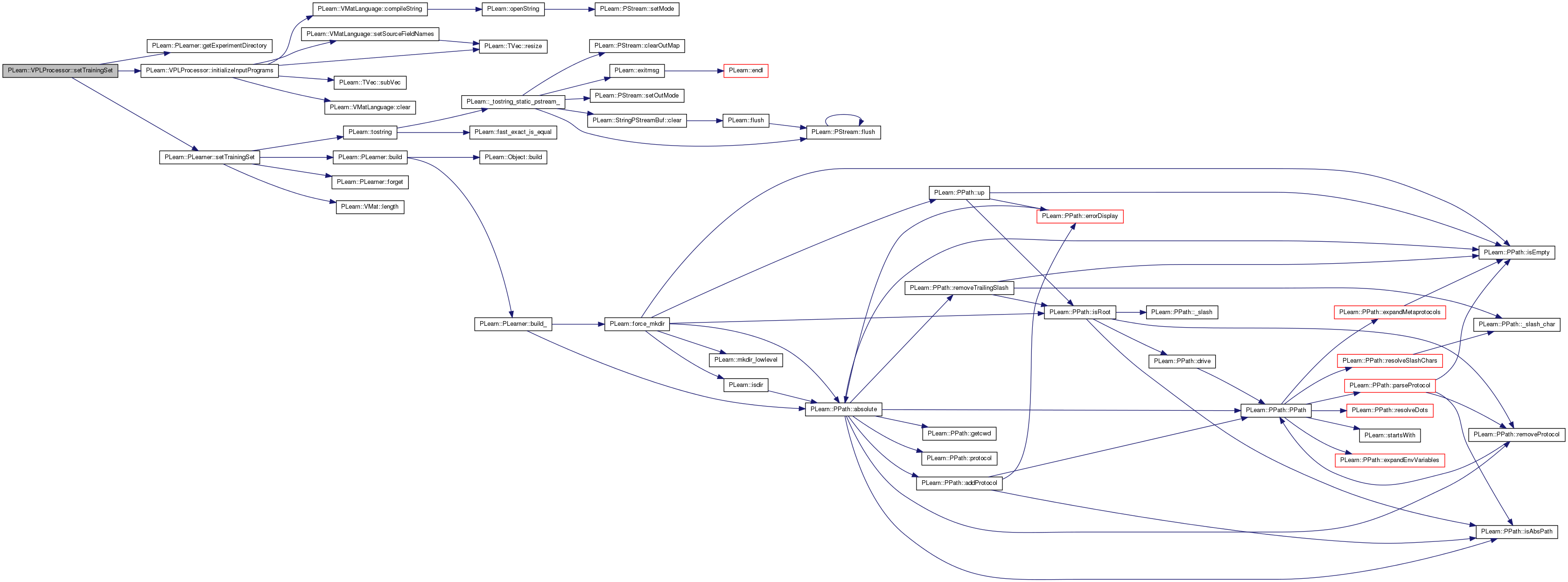
| void PLearn::VPLProcessor::train | ( | ) | [virtual] |
*** SUBCLASS WRITING: ***
The role of the train method is to bring the learner up to stage==nstages, updating the stats with training costs measured on-line in the process.
TYPICAL CODE:
static Vec input; // static so we don't reallocate/deallocate memory each time... static Vec target; // (but be careful that static means shared!) input.resize(inputsize()); // the train_set's inputsize() target.resize(targetsize()); // the train_set's targetsize() real weight; if(!train_stats) // make a default stats collector, in case there's none train_stats = new VecStatsCollector(); if(nstages<stage) // asking to revert to a previous stage! forget(); // reset the learner to stage=0 while(stage<nstages) { // clear statistics of previous epoch train_stats->forget(); //... train for 1 stage, and update train_stats, // using train_set->getSample(input, target, weight); // and train_stats->update(train_costs) ++stage; train_stats->finalize(); // finalize statistics for this epoch }
Implements PLearn::PLearner.
Definition at line 298 of file VPLProcessor.cc.
{}
Reimplemented from PLearn::PLearner.
Definition at line 136 of file VPLProcessor.h.
Definition at line 91 of file VPLProcessor.h.
Referenced by declareOptions(), processDataSet(), and setTrainingSet().
Definition at line 86 of file VPLProcessor.h.
Referenced by declareOptions(), processDataSet(), and setTrainingSet().
Definition at line 88 of file VPLProcessor.h.
Referenced by computeOutput(), declareOptions(), getOutputNames(), initializeInputPrograms(), outputsize(), processDataSet(), and setTrainingSet().
VMatLanguage PLearn::VPLProcessor::input_prg_ [protected] |
Definition at line 61 of file VPLProcessor.h.
Referenced by computeOutput(), initializeInputPrograms(), and makeDeepCopyFromShallowCopy().
TVec<string> PLearn::VPLProcessor::input_prg_fieldnames [protected] |
Definition at line 63 of file VPLProcessor.h.
Referenced by computeOutput(), getOutputNames(), initializeInputPrograms(), makeDeepCopyFromShallowCopy(), and outputsize().
TVec<string> PLearn::VPLProcessor::orig_fieldnames [protected] |
Definition at line 71 of file VPLProcessor.h.
Referenced by declareOptions(), initializeInputPrograms(), makeDeepCopyFromShallowCopy(), and setTrainingSet().
int PLearn::VPLProcessor::orig_inputsize [protected] |
Definition at line 72 of file VPLProcessor.h.
Referenced by build_(), declareOptions(), initializeInputPrograms(), and setTrainingSet().
int PLearn::VPLProcessor::orig_targetsize [protected] |
Definition at line 73 of file VPLProcessor.h.
Referenced by build_(), declareOptions(), and setTrainingSet().
Vec PLearn::VPLProcessor::processed_input [mutable, protected] |
Definition at line 65 of file VPLProcessor.h.
Referenced by computeOutput(), and makeDeepCopyFromShallowCopy().
string PLearn::VPLProcessor::repeat_count_field_name [protected] |
Definition at line 77 of file VPLProcessor.h.
Referenced by declareOptions(), processDataSet(), and setTrainingSet().
string PLearn::VPLProcessor::repeat_id_field_name [protected] |
Definition at line 76 of file VPLProcessor.h.
Referenced by declareOptions(), processDataSet(), and setTrainingSet().
Definition at line 89 of file VPLProcessor.h.
Referenced by declareOptions(), processDataSet(), and setTrainingSet().
Definition at line 75 of file VPLProcessor.h.
Referenced by declareOptions(), processDataSet(), and setTrainingSet().
Definition at line 90 of file VPLProcessor.h.
Referenced by declareOptions(), processDataSet(), and setTrainingSet().
 1.7.4
1.7.4